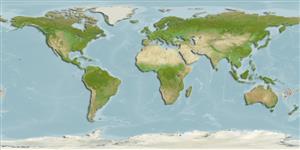Classificatie / Names
Lokale namen | Synoniemen | Catalog of Fishes(Genus, Soort(en)) | ITIS | CoL | WoRMS | Cloffa
>
Pleuronectiformes (Flatfishes) >
Poecilopsettidae (Bigeye flounders)
Etymology: Poecilopsetta: Greek, poikilos = with a lot of colours + Greek, psetta = grouper (Ref. 45335); multiradiata: This new species is named from the Latin multus (numerous) and radius (rays) in reference to its high number of dorsal fin rays (Ref. 84061).
Environment: milieu / climate zone / depth range / distribution range
Ecologie
marien bathydemersaal; diepte 336 - 480 m (Ref. 84061). Temperate; 18°S - 28°S, 163°W - 173°W
Verspreiding
Landen | FAO regio's | Ecosystemen | Voorkomen | Point map | Introducties | Faunafri
Pacific Ocean: New Caledonia and New Zealand (Ref. 84061).
Grootte / Gewicht / Leeftijd
Maturity: Lm ? range ? - ? cm
Max length : 155 cm SL mannelijk / geslacht onbekend; (Ref. 84061); 16.5 cm SL (female)
Korte beschrijving
Morfologie | Morfometrie
A species of the genus Poecilopsetta with the following combination of characters: high number of dorsal (70–73) and anal (58–62) fin rays, ca. 85–99 lateral-line scales, 31–32 caudal vertebrae, and relatively shallow body depth (36.9–41.9% SL).
Body compressed and elliptical. Head small and compressed. Snout short. Ocular-side anterior nostril a short tube situated on snout anterior to lower eye on the horizontal through middle of lower eye; ocular-side posterior nostril very short tube situated at anterior margin of interorbital space. Eyes dextral and small, separated by narrow bony ridge. Mouth small and oblique, maxilla extending to point between verticals through anterior margin of pupil and mid-point of lower eye; tip of lower jaw with very small symphyseal knob; lower jaw extending to vertical through middle of lower eye; band of small teeth on each jaw, tooth bands on blind-side jaws more developed than those on ocular-side jaws. Vomer and palatines toothless. Gill rakers on first arch not serrated, and slender on both limbs. Gill membranes united.
Scales very small and deciduous; ctenoid on ocular side, cycloid on blind side. Eyes, both jaws, and snout from tip to anterior interorbital region scaleless. Lateral line on ocular side strongly curved above pectoral fin; lateral line absent on blind side.
Dorsal fin origin on blind side of head at point equal to vertical through middle of upper eye. Anal fin origin posterior to anus on mid-ventral line. All dorsal fin rays, except for first ray, and all anal fin rays simple. First dorsal fin ray usually branched (simple in MNHN 2008-2207 and 2008-2208). Pectoral fin on both sides small; anterior 3 (2–3) rays on ocular side and all rays on blind-side fin simple. Pelvic fins small, first ray on blind-side fin opposite third ray of ocular-side fin; all ocular-side pelvic fin rays usually branched (all unbranched in MNHN 2008-2208), posterior 4 (0–4) rays branched in blind-side pelvic fin. Caudal fin rounded, inner 14 (15 in MNHN 1994-0814) rays branched, other rays simple. Anus on mid-ventral line. Urogenital papilla very small, located on ocular side slightly dorsal to anus (Ref. 84061).
Levenscyclus en paargedrag
Maturiteit | Voortplanting | Paaien | Eieren | Fecunditeit | Larven
Kawai, T., K. Amaoka and B. Séret, 2010. A new righteye flounder, Poecilopsetta multiradiata (Teleostei: Pleuronectiformes: Poecilopsettidae), from New Zealand and New Caledonia (South-West Pacific). Ichthyol. Res. 57:193-198. (Ref. 84061)
Status op de Rode Lijst van het IUCN (Ref. 130435)
Gevaar voor de mens
Harmless
Gebruik door de mens
Meer informatie
LandenFAO regio'sEcosystemenVoorkomenIntroductiesStocksEcologieDieetVoedselitemsVoedselconsumptieRantsoen
Lokale namenSynoniemenMetabolismePredatorenEcotoxicologieVoortplantingMaturiteitPaaienPaaiaggregatiesFecunditeitEierenOntwikkeling van de eieren
Leeftijd/GrootteGroeiLengte-gewichtLengte-lengteLengtefrequentiesMorfometrieMorfologieLarvenLarvale populatiedynamiekRekruteringAbundantieBRUVS
ReferentiesAquacultuurAquacultuurprofielKweeklijnenGeneticaElectrophoresesErfelijkheidZiektesVerwerkingNutrientsMassaconversie
Tools
Speciale rapporten
Download XML
Internetbronnen
Estimates based on models
Preferred temperature (Ref.
123201): 3.1 - 6.5, mean 4.5 °C (based on 67 cells).
Fylogenetische diversiteitsindex (Ref.
82804): PD
50 = 0.5000 [Uniqueness, from 0.5 = low to 2.0 = high].
Bayesian length-weight: a=0.01995 (0.00906 - 0.04395), b=3.01 (2.83 - 3.19), in cm total length, based on all LWR estimates for this body shape (Ref.
93245).
Trofisch niveau (Ref.
69278): 4.1 ±0.5 se; based on size and trophs of closest relatives
Fishing Vulnerability (Ref.
59153): Very high vulnerability (90 of 100).
